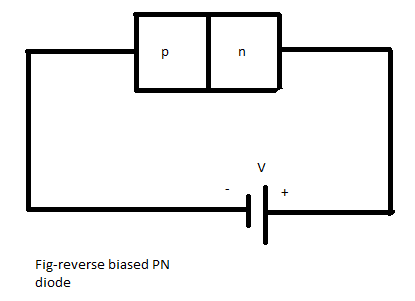
In reverse bias, pn-junction diode depletion layer width:
A. Decreases
B. Increases
C. Remains same
D. Can’t predict
Answer
575.1k+ views
Hint: First let us see what is meant by reverse bias-
The bias applied is referred to as reverse bias when the negative terminal of the battery is attached to p-type and the positive battery terminal is fastened to the N-type of the pn-junction.
Complete step by step solution:
First let us see how pn-junction is formed-
In a piece of semiconductor material, if one half is doped by the P-type impurity, a pn-junction is formed with the other half doped by N-type impurity. The high concentration of free electrons is in the N-type material, while the maximum concentration of holes is in the P-type material. Therefore, there is a potential for free electrons at the junction to diffuse through to the P-side and holes to the N-side. This process is called diffusion. If the free electrons pass through the junction from N-type to P-type, the donor ions become positively charged. A positive charge is then formed on the junction’s N-side. Similarly, the P-side of the junction is configured as a negative charge.
Now we shall see the operation of a pn-junction diode under reverse biased condition-

Under the implemented reverse bias, holes forming the bulk of the P-side carriers pass towards the battery’s negative terminal and electrons forming the N-side bulk carrier are drawn to the battery’s positive terminal. The depletion area, which is reduced by mobile charge carriers, therefore, increases in width.
From the above discussion we can see that the depletion width increases.
Hence, option B is correct.
Note: The width of the depletion region is totally dependent on the reverse bias. If the reverse decreases the depletion region width also decreases and if the reverse bias increases the depletion region also increases. Basically we can say that the width of the depletion layer increases due to the bulk formation of electrons and holes.
The bias applied is referred to as reverse bias when the negative terminal of the battery is attached to p-type and the positive battery terminal is fastened to the N-type of the pn-junction.
Complete step by step solution:
First let us see how pn-junction is formed-
In a piece of semiconductor material, if one half is doped by the P-type impurity, a pn-junction is formed with the other half doped by N-type impurity. The high concentration of free electrons is in the N-type material, while the maximum concentration of holes is in the P-type material. Therefore, there is a potential for free electrons at the junction to diffuse through to the P-side and holes to the N-side. This process is called diffusion. If the free electrons pass through the junction from N-type to P-type, the donor ions become positively charged. A positive charge is then formed on the junction’s N-side. Similarly, the P-side of the junction is configured as a negative charge.
Now we shall see the operation of a pn-junction diode under reverse biased condition-

Under the implemented reverse bias, holes forming the bulk of the P-side carriers pass towards the battery’s negative terminal and electrons forming the N-side bulk carrier are drawn to the battery’s positive terminal. The depletion area, which is reduced by mobile charge carriers, therefore, increases in width.
From the above discussion we can see that the depletion width increases.
Hence, option B is correct.
Note: The width of the depletion region is totally dependent on the reverse bias. If the reverse decreases the depletion region width also decreases and if the reverse bias increases the depletion region also increases. Basically we can say that the width of the depletion layer increases due to the bulk formation of electrons and holes.
Recently Updated Pages
Master Class 11 Economics: Engaging Questions & Answers for Success

Master Class 11 English: Engaging Questions & Answers for Success

Master Class 11 Social Science: Engaging Questions & Answers for Success

Master Class 11 Biology: Engaging Questions & Answers for Success

Class 11 Question and Answer - Your Ultimate Solutions Guide

Master Class 11 Business Studies: Engaging Questions & Answers for Success

Trending doubts
10 examples of friction in our daily life

One Metric ton is equal to kg A 10000 B 1000 C 100 class 11 physics CBSE

Difference Between Prokaryotic Cells and Eukaryotic Cells

1 Quintal is equal to a 110 kg b 10 kg c 100kg d 1000 class 11 physics CBSE

Explain zero factorial class 11 maths CBSE

What is a periderm How does periderm formation take class 11 biology CBSE




